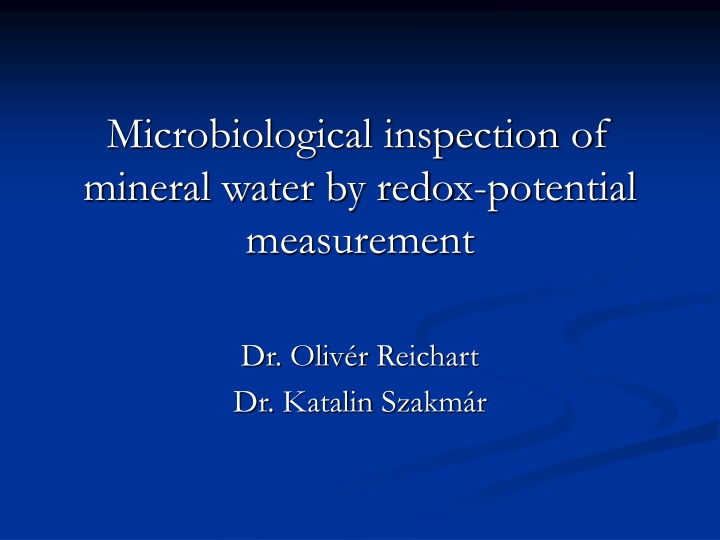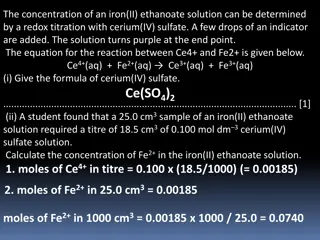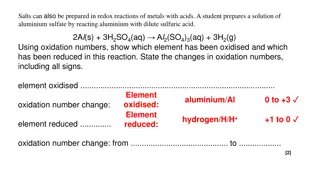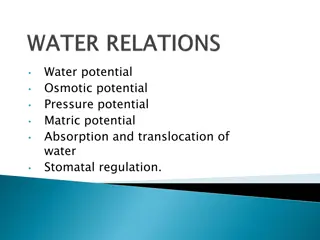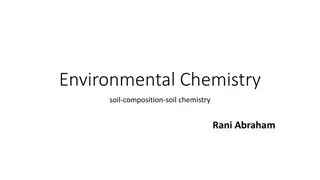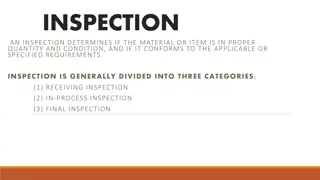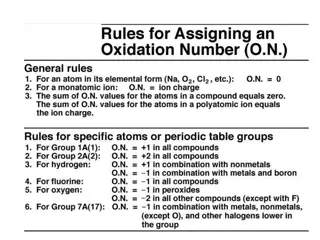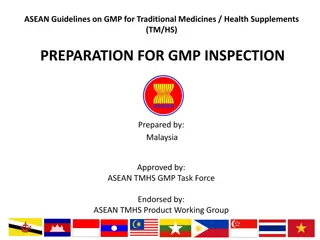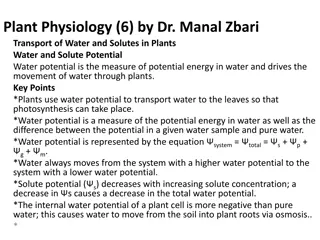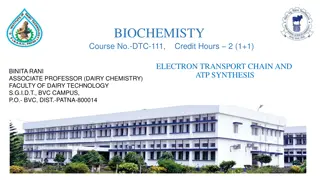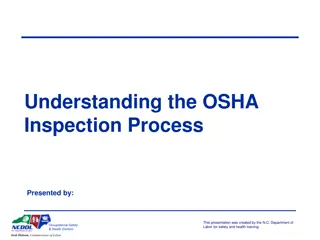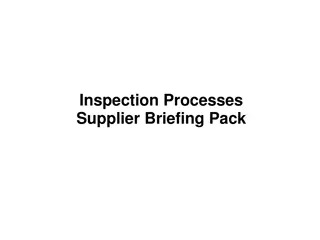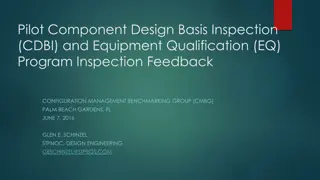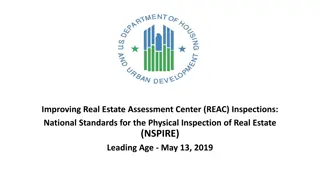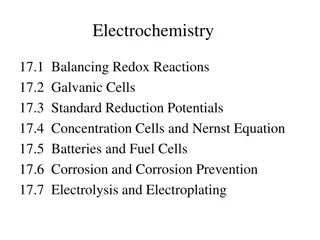Microbiological Inspection of Mineral Water by Redox Potential Measurement
MicroTester is a validated method for rapid microbiological testing of various types of water such as mineral water and carbonated water. Real-time monitoring of microbial properties in water production is crucial for ensuring safety and quality. The energy for microbial growth comes from biological oxidation, resulting in a reduction in the environment. Selectivity, linearity, sensitivity, detection limit, repeatability, and robustness are key aspects of method validation. The most commonly tested contaminant microorganisms in mineral water production include coliforms, Escherichia coli, Pseudomonas aeruginosa, and Enterococcus faecalis.
Download Presentation

Please find below an Image/Link to download the presentation.
The content on the website is provided AS IS for your information and personal use only. It may not be sold, licensed, or shared on other websites without obtaining consent from the author.If you encounter any issues during the download, it is possible that the publisher has removed the file from their server.
You are allowed to download the files provided on this website for personal or commercial use, subject to the condition that they are used lawfully. All files are the property of their respective owners.
The content on the website is provided AS IS for your information and personal use only. It may not be sold, licensed, or shared on other websites without obtaining consent from the author.
E N D
Presentation Transcript
Microbiological inspection of mineral water by redox-potential measurement Dr. Oliv r Reichart Dr. Katalin Szakm r
Introduction MicroTester as a validated method is suitable for rapid microbiological testing of mineral water, carbonated water, tank and running drinking water and other types of water. The time needed for a reliable detection of microorganisms is of key importance: in water industry the real-time (or at least as fast as possible) monitoring of the microbiological properties of the production is indispensable; in public water supply the essential basis of the epidemiological and public health measures is the fast and reliable result of the microbiological inspection. Beside the most important and most widely inspected microbiological contaminants the most relevant disturbing flora was involved to the validation process as well.
Theoretical base The energy source of the growth is the biological oxidation which results in a reduction in the environment. This is due to the oxygen depletion and the production of reducing compounds in the nutrient medium. A typical oxidation-reduction reaction in biological systems: [Oxidant] + [H+] + n e- [Reductant]
A typical redox curve of the microbial growth DC: Detection Criterion TTD: Time to Detection
Microorganisms The most frequently tested contaminant microorganisms in mineral water productions are: Coliforms Escherichia coli Pseudomonas aeruginosa Enterococcus faecalis Total count (22 C and 37 C)
Method validation Selectivity Linearity Sensitivity Detection limit Repeatability Robustness
Selectivity 1. Coliforms and Acinetobacter in BBL 600 400 Eh (mV) 200 0 -200 -400 0 5 10 15 20 t (h) K.o.lgN=3,55 E.c. lgN=3,67 Citro lgN=3 Acin. lgN=3,65 Ent lgN=3,48 Coliforms and Acinetobacter lwoffii in BBL. (K.o.: Klebsiella oxytoca, Ent.: Enterobacter aerogenes, Citro.: Citrobacter freundii, E.c.: Escherichia coli, Acin.: Acinetobacter lwoffii)
Selectivity 2. Enterococcus and Micrococcus 400 350 300 250 Eh (mV) 200 150 100 50 0 0 5 10 15 20 t (h) Enterococcus Micrococcus Micrococcus and Enterococcus in Azid broth
Selectivity 3. Growth in Cetrimide broth 500 400 Eh (mV) 300 200 100 0 0 5 10 15 20 25 t (min) Ps. aeruginosa Ps. fluoresc. E. coli Enterococcus Pseudomonas aeruginosa, Pseudomonas fluorescens, E. coli and Enterococcus faecalis in Cetrimid broth.
Linearity The linear relationship between the logarithm of the cell concentration and TTD values is demonstrated by the calibration curves. From the concentrated suspensions of the test microorganisms tenfold dilution series were prepared in physiological salt solution. From the members of the dilution series the redox-potential test flasks were inoculated with 1.0 ml suspension and the TTD values were determined.
Linearity Coliforms in BBL 20 y = -1.699x + 17.004 R2 = 0.9958 y = -1.471x + 14.26 R2 = 0.9714 15 y = -1.3506x + 12.896 R2 = 0.9941 TTD (h) 10 5 y = -1.1775x + 10.184 R2 = 0.9907 0 0 1 2 3 4 5 6 7 lgN (cfu/cell) Citrobacter Klebsiella oxytoca Enterobacter E. coli (37 C) Calibration curves of Coliforms
Linearity Escherichia coli 8 y = -0.8393x + 7.1607 R2 = 0.9988 6 TTD (h) 4 2 0 0 1 2 3 4 5 6 7 logN/100 ml Calibration curve of E. coli
Linearity Enterococcus Azid 15 y = -1.5873x + 13.222 R2 = 0.9859 10 TTD (h) 5 0 0 1 2 3 4 5 6 7 8 logN/100ml Calibration curve of Enterococcus faecalis
Linearity Pseudomonas aeruginosa Cetrimid 25 y = -2.5536x + 23.709 R2 = 0.9882 20 15 TTD (h) 10 5 0 0 1 2 3 4 5 6 7 8 logN/100ml Calibration curve of Pseudomonas aeruginosa
Linearity Total count (37 C) 10 y = -1.0135x + 8.7505 R2 = 0.9973 8 6 TTD (h) 4 2 0 0 1 2 3 4 5 6 7 8 logN/100ml Calibration curve of total count
Sensitivity The sensitivity of the measuring method was determined as the slope of the calibration curves. Microorganism Broth Regression equation Sensitivity (min/log unit) 132 Citrobacter freundii BBL TTD (min) = 1190 - 132 lgN Klebsiella oxytoca BBL TTD (min) = 856 88 lgN 88 Enterobacter aerogenes BBL TTD (min) = 774 81 lgN 81 Escherichia coli BBL TTD (min) = 596 68 lgN 68 Pseudomonas aeruginosa Cetrimid TTD (min) = 1440 155 lgN 155 Enterococcus faecalis Azid TTD (min) = 836 92 lgN 92
Detection limit The detection limit is 1 cell/test flask, so the system is suitable for the absence/presence tests, so considerable costs and time could be saved with more membrane filters joined together. On the base of the calibration curves the range lasted from 1 to 7 log unit.
Repeatability The repeatability calculated from the calibration curves: SDlgN= 0.092 SDN= 100.092= 1.24 = 24% which complies with the requirements of microbiological methods.
Quality control tests 72 bottles tested for Coliform Testing method of Laboratory Membrane filtering of 3x250 ml mineral water with 1 filter. Cultivation Tergitol agar at 37 C for 48 h. One Petri dish represents 3 bottles of mineral water. Redox-potential measurement method Membrane filtering of 3x250 ml mineral water with 1 filter, placing 4 membranes into 1 test flask containing BBL broth. Temperature: 37 C. One test flask represents 12 bottles of mineral water. Positive control: 1 ml of Citrobacter freundii suspension (lgN = 3.66)
Quality control test 72 bottles 600 500 400 300 200 Eh (mV) 100 0 -100 -200 -300 -400 0 2 4 6 8 10 12 14 16 18 20 22 24 26 t (h) 1. - 12. 49. - 60. 13. - 24. 61. - 72. 25. - 36. Citrobacter 37. - 48. Results of redox-potential measurement of 72 bottles
Quality control test Results of 72 bottles test Bottles 1.-12. 13.-24. 25.-36. 37.-48. 49.-60. 61.-72. Laboratory negative negative negative negative negative negative Redox negative negative negative negative negative negative
66 bottles tested for Coliforms Testing method of Laboratory Membrane filtering of 3x250 ml mineral water with 1 filter. Cultivation Tergitol agar at 37 C for 48 h. One Petri dish represents 3 bottles of mineral water. Redox-potential measurement method Membrane filtering of 3x250 ml mineral water with 1 filter, placing 3 membranes into 1 test flask containing BBL broth. Temperature: 37 C. One test flask represents 9 bottles of mineral water. Besides the mineral water two technological water samples were tested for Coliforms Positive control: 1 ml of Escherichia coli suspension (lgN = 6.7)
Quality control test 66 bottles 500 400 300 200 Eh (mV) 100 0 -100 -200 -300 -400 0 2 4 6 8 10 12 14 16 18 20 22 24 t (h) 1.-9. 55.-63. 10.-18. 64.-66. 19.-27. E.coli (+) 28.-36. Negativ 37.-45. 46.-54. Results of redox-potential measurement of 66 bottles
Quality control test Results of 66 bottles test Samples 1.-66. Bottles Water sample 1. Water sample 2. Laboratory results negative negative negative Redox method negative negative negative
Detection time of one cell Microbe One cell detection time (h) Escherichia coli Citrobacter freundii Pseudomonas aeruginosa Enterococcus faecalis 11 23 24 15
Results of industrial tests False positive results (%) False negative results (%) All Match the standard test (%) Microbe measurements (piece) Escherichia coli 942 99,89 0,11 0,00 Coliform 4674 99,87 0,00 0,13 Enterococcus 3000 99,93 0,00 0,07 Pseudomonas aeruginosa 3372 99,82 0,06 0,12
Advantages of the redox-potential measurement Very simple measurement technique. Rapid method, especially in the case of high contamination. Applicable for every nutrient broth Especially suitable for the evaluation of the membrane filter methods. The test costs are less than those of the classical methods, especially in the case of zero tolerance (Coliforms, Enterococcus, Pseudomonas, etc.).
